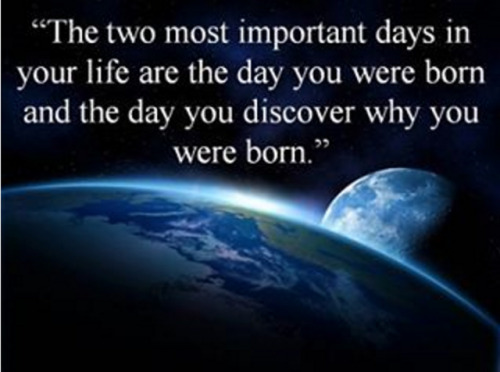Text
Re-envisioning Purpose & Goals
I haven’t blogged in ages. Been busy working on earning my Master’s degree, and still just wasn’t sure exactly what I wanted this blog to be. I’m beginning to get a handle on that, as my writing goals include taking bigger risks and my course load is starting to wind down. (Three weeks left of my current semester, then only one more semester to go - AND all that will entail is taking one final course...)
This week in my writing course, we’ve been focused on two things: revision and fear. Seems I’m right on time them on re-envisioning certain things in my life, including what I’m doing with this blog. Another glaring one at the moment has to do with my practices (or lack thereof) in terms of my physical health and well-being. So I’ve decided to take an internal dive on that external aspect of my life, AND I’m going to use this blog as a place to record that. Stay tuned...
1 note
·
View note
Text
Jungian Theory & American Politics
We’re living through a crisis in our democracy. There’s a lot of upset, and we are needed. We are needed to be people who can endure this time, and we are needed to be people who can transform this time. And that transformation doesn’t come about by denying that there is upset happening. There’s a difference between transcendence and denial.~ Marianne Williamson, June 27, 2018

So far, the twenty-first century has been tumultuous for the United States in ways that many could not fathom even just a few years prior to it. In a quick succession of challenges, each more daunting than the one before, Americans faced uncertainty at the turn of this century. On its very eve, many were preoccupied with concerns of Y2K. Soon after the new year dawned without such disaster striking, the results of a presidential election came down to a verdict by the United States Supreme Court; something no twenty-first century American had ever before personally experienced. And of course, less than a year after that president took the oath of office, there was the unprecedented attack by terrorists on U.S. soil. This event left a deep mark on the soul of the nation, creating a demarcation within the psyche of society and leading us forward into a war on terrorism that is yet without end. As is expected in times of war, safety is compromised in mind and body creating fearful thinking, a sense of lack, and a need for protection.
In addition to soldiers, time has marched onwards, as have our daily lives. Such living now includes technology that has fundamentally shifted the way in which we produce, share, and interpret information. Never before has there been such ease in communication over vast geographical distances. The rise of social media has provided many ways of “staying connected” and engaged with others. Engaging more frequently over a wider variety of topics than ever before, we are currently dealing with the paradoxical results of unification and division of such engagement. During the most recent presidential election campaign, foreign enemies intentionally used social media to further such division among Americans. Enemies both foreign and domestic continue grow division, with great ease, in a society in which social media rules its foreground while it holds perpetual war in its background. These days, it seems most on social media have become soldiers in a political war of words while simultaneously begging for peace. Is it any wonder then why so many feel so much despair, even as their personal lives may hold many blessings?
Though times may be dark, all is not lost. Calling upon Swiss psychiatrist Carl Gustav Jung as a trusted guide, it is possible to see such darkness as an instrument of healing, transformation, and enlightenment. Jung’s theory of personality provides a useful map in leading the individual and society away from a dichotomy of either/or thinking and into more expanded possibilities of “both and” in terms of personal growth and the greater good. Introspection that includes the examination of the archetype of the shadow provides opportunities to take personal responsibility individually and collectively for the sake of personal and political well-being.
The Human Psyche
Jung describes the human psyche, or mental functioning, as consisting of different levels of awareness (Vaughn, 2013). Jung envisions three levels of personality in such a way that first separates consciousness,or one’s field of awareness, from that of the unconscious using a line of division known as the “threshold of consciousness” (March 2018). The unconscious, or psychological functioning of which one is not aware, is further distinguished by Jung in the aspects of the personal and the collective. The personal unconscious is composed of elements from one’s individual experience while the collective unconscious is composed of elements which are believed to be inherited and shared by all humans (Jan. 2016).

Archetypes: Inherited Patterns
Jung’s theory of the collective unconscious derives from his work among the Pueblo Indian tribes residing in Arizona and New Mexico as well as among tribes that inhabited the islands of Oceania and inhabitants of Africa and Asia Oceania (Adamski, 2011). The collective unconscious is seen as the instincts (biologically conditioned response patterns) and archetypes (symbols, images, and patterns of thinking and behavior) inherited from our ancestors. Adamski (2011) builds upon Jung’s theory of the collective unconscious through quantum psychology, “which recognizes that quantum processes occur in the biological system and they are capable of recording information about the life of the individual in its ontogeny, but also save life process in the generational dimension.” Borrowing from Popp and Beloussoy (2003), Adamski explains that physical evidence suggests that “living matter has a ‘quantum logic’ which enables the optimal use of ‘information’ from the environment to its own stability and to escape from chaos…Biological material grows rapidly in the electromagnetic field, wherein a result of field coupling and coherent states of matter created in the process of life is required. This means that biological matter creates a system that absorbs electromagnetic impulses, and stores and uses them to create permanent psychobiological structures” (2011).
While archetypes (universal patterns) reside within the collective unconscious, they structure consciousness and “hold potential for human experience mediated in interactions with the environment across cultures and the ages” (Vaughn, 2013). In her lecture on archetypal affects, Anita Green Ph. D. reminds us of Jung’s understanding of the body-psyche connection (2015). Jung believes that our conscious is formed by the content received from the four mental functionsof perception, thinking, feeling, and intuition. Perception tells us that something exists while thinking tells us “what” exists; feeling allows us to judge whether something is pleasant or unpleasant, and intuition is the perception of the possibilities contained within a given situation (Adamski, 2011).

Jung explains, “When one reflects upon what consciousness really is, one is profoundly impressed by the extreme wonder of the fact that an event which takes place outside in the cosmos simultaneously produces an internal image, that it takes place, so to speak, inside as well, which is to say: become conscious” (1961, p. 382). Jung also states, “For indeed our consciousness does not create itself – it wells up from unknown depths. In childhood it awakens gradually, and all through life it wakes each morning out of the depths of sleep from an unconscious condition. It is like a child that is born daily out of the primordial womb of the unconscious” (1968, p. 935).
Ego and Persona
The most commonly understood aspects of Jung’s personality theory within the mainstream are that of the ego and the persona. The mechanism of self-identity, or ego, can be seen as the center of one’s awareness. Vaughn (2013) describes ego as “the focal point of consciousness manifest in the cognitive-sensory functions. The ego mediates between subjective and objective realms of experience with a focus on decoding cultural symbols and adapting to acceptable norms of behavior.” Vaughn then explains persona as the packaging of the ego or its “public relations firm” and that for Jung, this is a role a person plays, and is responsible for advertising to people how one wants to be seen and received” (2013). Jung describes the persona as a compromise between the individual and society, that creates a two-dimensional reality; the persona is often referred to as a mask worn during interactions with others in society (January 2016). Though it is not uncommon for people to suffer from an inflation of the persona, problems arise when people over-identify with this social mask, which can become obstacles in the process that Jung called individuation (Feb. 2016).

The Self and Individuation
According to Jung, “I use the term ‘individuation’ to denote the process by which a person becomes a psychological ‘individual,’ that is, a separate, indivisible unity or ‘whole’” (Jung, 1968, p. 275). In other words, individuation is the path to self-knowledge or self-realization that is essential for healthy functioning of the personality (Feb. 2016). According to Vaughn (2013), the self can be viewed as the main archetype among the various archetypes and is responsible for “implementing the blueprint of life through each stage of the life cycle and bringing about the best adjustment that individual circumstances will allow…The goal of the self is wholeness or individuation.” Vaughn also explains that while the ego is “privy to purely conscious preoccupations,” the self has “access to a much wider realm of existential experience” (2013).
Complexes and the Shadow
Despite frequent mainstream references, less understood aspects of Jung’s theory of personality among the general population are that of complexesand the archetype of the shadow. Within the personal unconscious, contents may come together to form a cluster of constellation that Jung refers to as a complex (Jan. 2016). Vaughn (2013) describes a complex as a “group of associated ideas bound together by a shared emotional charge or feeling toned response,” and explains that complexes are “the means through which archetypes manifest themselves in personal psyche, the collective group psyche, and cultural environments.” Borrowing from Stevens (1991), Vaughn states that a complex exerts “a dynamic effect on conscious experience and on behavior” and also notes a “close functional relationship exists between archetypes and complexes, in that complexes are personifications of archetypes” (2013). While a strong complex is easily noticed by others, “the person himself may not be aware of it” since the root of such complexes reside in a deep level of the psyche within the collective unconsciousness. Therefore, complexes can be seen as “subpersonalities” which have potential to “exert powerful control over one’s thoughts, emotions, and behaviors” (March 2018).
The mental function of feeling is an essential aspect in the formation of such complexes as well as other parts of the personal unconscious, since it is by way of the emotionally charged pieces of our personal history that elements of personal unconscious are formed. These aspects of our personal history unconsciously impact our perception and thinking in many areas until they are brought into awareness and integrated. Green (2015) refers her audience to the words of Daniel Stern (n.d.) as a reminder that “emotion serves as the central organizing process within the brain.” One cannot directly view the unconscious. The only way to see the unconscious is to see its aspects reflected in someone or something else (Feb. 2016). As we encounter such reflections, Green notes the importance of the body-psyche connection in that we will feel sensations in the body that point to emotionally charged pieces of our history stored within the unconscious (2015). Tuning into such physical sensations and emotional charges with curiosity allows opportunities to explore one’s personal unconscious when encountering its reflections.
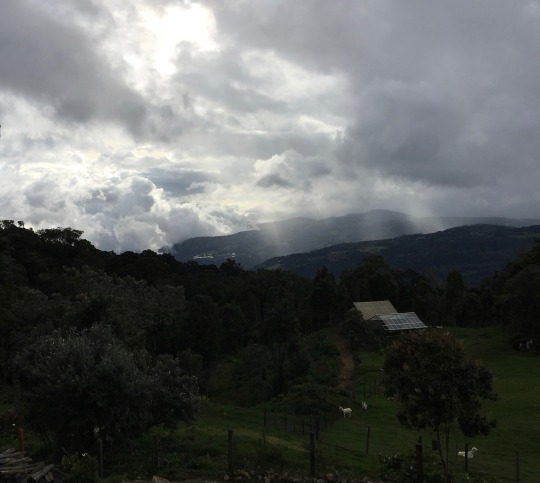
For a firmer grasp of the personal unconscious archetype of the shadow, it may be helpful to see the ego functioning as a gatekeeper. As such, the ego determines which contents are brought into the awareness and which contents are repressed or ignored, thereby relegated to the unconscious realm of the shadow. The function of the shadow is to represent “qualities opposite to those manifested in the persona;” these two aspects of personality “complement and counterbalance each other” (Vaughn, 2013). Although this aspect of the psyche is unconscious, as Vaughn states, it “remains dynamically active” because it carries the rejected aspects of the ego, and “for the ego to own its contents is painful, if not terrifying” (2013).
Since the shadow contains those emotions, qualities, and impulses denied by the ego of self-identify, it is often viewed by the mainstream as simply the negative aspects of self. However, the shadow compensates for the “pretension of the persona” just as the persona “compensates for the antisocial propensities of the shadow” (Vaughn, 2013). Additionally, during one’s formative years, the ego may have actually rejected the incorporation of qualities that could actually be viewed as positive. For example, if one’s family or culture operated in ways that did not include any discussion of emotion, that quality may then be repressed by the ego and relegated to one’s shadow. While the ability to discuss emotions could be seen by others as a positive and even healthy quality, in such a case, this positive quality would be contained within one’s shadow rather than integrated as part of the ego. Therefore, the shadow contains qualities that many would deem as “positive” as well as “negative” ones.
Hidden Treasure
Because the shadow contains positive qualities and acts as a counterbalance to the two-dimensional social mask of the persona, it could be considered in less negative and more neutral ways by the general population. In fact, it may be healthier and more effective in the individuation process for one to see the shadow in more neutral terms. While it may be more of a challenge to appreciate the shadow for the resources it provides, it would most likely serve us well to keep in mind that, as Jung put it, “your shadow contains gold” (March, 2018).
For the majority of people to continue to view the shadow in simply negative terms is limiting in that it creates an even deeper aversion of the shadow. Aversion creates feelings of disgust and contempt, which are counterproductive to individuation when faced with reflections of one’s own shadow. These reflections are most often delivered to us in our dreams and through our projection of these qualities onto others. The greater the number of individuals engaging with the shadow in such negative ways, the greater amount of disgust and contempt are generated in personal exchanges.
Holding Others in Contempt
Even the most cursory examination of today’s media demonstrates how prolific such contempt for “the other” is expressed within our public sphere. During a recent forum, American Enterprise Institute president Arthur Brooks states, “We don’t have an anger problem in American politics, we have a contempt problem in American politics.” Supporting his claim using a definition of contempt by social psychologists as “the utter conviction of the worthlessness of another human being,” Brooks also shares insight provided to him by the Dalai Lama as to a remedy for contempt: the practice of ‘warm-heartedness’ (2017).

In recounting two recent examples of political commentary created by people to whom she is connected on social media, Hess (2018) states “I begin with a fairly large assumption that…(a) supermajority of persons in the United States is suffering from a perceptual malady: we do not know what we do not know, besieged in our quests for certainty. We seem to be less and less able to perceive others accurately, in our multimedia-driven fear and habits of blame. We struggle to allow anyone’s suffering to be legitimate in its own terms, held with compassion. “Shadowdancing” is a three-dimensional key to this malady that…invites a vulnerability to what many call shadow– or our greatest hidden potentials/passions and our greatest fears/sacred wounds…shadowdancing leans into a natural perceptual process called projection….But we can learn to reverse this outward process and withdraw our attention back to the sensation of fear and its refusal in our own sub- or unconscious. Shadow and projection name the dynamic two-dimensional movement human beings have made toward deeper understanding for ages. A third dimension can hold them in a transformative way.” Hess offers readers an invitation to consider shadowdancing within a “container/contained ecology” as a way to enter vulnerability and withdraw projections “back into the Self toward wholeness, connection, and transformation” (2018).
Ignoring Complications and the Ugly Bits
In a recent TEDTalk, historian Yuval Noah Harari discusses fascism as well as what he sees as the greatest danger to liberal democracy. Harari notes how our different identities and loyalties create internal conflicts and complications, and explains, “Fascism is what happens when people try to ignore the complications and to make life too easy for themselves. Fascism denies all identities except the national identity” insisting that the individual has obligations only to the nation. “Fascism makes people see themselves as belonging to the most beautiful and most important thing in the world -- the nation. And then people think, ‘Well, they taught us that fascism is ugly. But when I look in the mirror, I see something very beautiful, so I can't be a fascist, right?’ Wrong. That's the problem with fascism. When you look in the fascist mirror, you see yourself as far more beautiful than you really are” (2018).
Know Thyself, Heal Thyself
To prevent a twenty-first century rise of fascism, Harari advises us not to allow ourselves to be manipulated by those who control the data. He explains that the enemies of liberal democracy have a method in doing so. “They hack our feelings – they hack our feelings of fear and hate and vanity, and then use these feelings to polarize and destroy democracy from within...but they cannot create these feelings out of nothing. So they get to know our own preexisting weaknesses. And then use them against us. And it is therefore the responsibility of all of us to get to know our weaknesses and make sure that they do not become a weapon in the hands of the enemies of democracy” (2018). Getting to know our individual and collective shadow allows us to integrate and transmute the qualities held within these shadows.
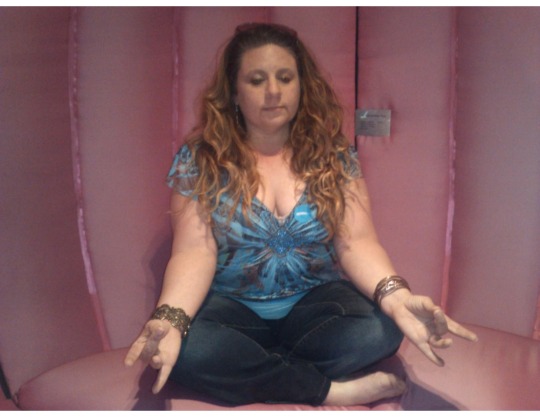
The Antidote: Compassion, Integration, and Transmutation
Application of Jung’s theory of personality along with practices such as shadowdancing and warm-heartedness offer us an antidote to the epidemic of contempt we’re currently experiencing in American politics and everyday conversations. Such practices allow us to hold ourselves and others in ways that allow us to raise the level of conversations beyond the limited dichotomy of “either/or” and into greater possibilities of “both and.” The greater the number of individuals taking personal responsibility in their own psycho-spiritual growth and individuation process, the greater it will benefit society as a whole. Through the effective use of Jung’s map, we can become miners of the gold contained within our shadows and enjoy the wealth it provides us individually as well as collectively as we march onwards within and beyond the twenty-first century.
References
Academy of Ideas (2016, January 09). Introduction to Carl Jung - The Psyche, Archetypes and the Collective Unconscious. Retrieved fromhttps://www.youtube.com/watch?v=j0KzUS0b_uc
Academy of Ideas (2016, February 13). Introduction to Carl Jung - Individuation, the Persona, the Shadow, and the Self. Retrieved from https://www.youtube.com/watch?v=uhAeXyVDDTc
Adamski, A. G. (2011). Archetypes and Collective Unconscious Compared to Development Quantum Psychology. NeuroQuantology, 9(3). doi:10.14704/nq.2011.9.3.413
Brooks, Arthur (2017, May 6). American Enterprise Institute Forum. Harvard Kennedy School.Retrieved from https://www.facebook.com/harvardkennedyschool/videos/the-real-problem-with-american/10154251688431403/
Green, A. Ph.D. (2015, March 01). Lecture Archetypal Affects: Shame / Contempt. Retrieved from https://www.youtube.com/watch?v=fXp9k8pLzgk
Harari, Y. (2018, April). Why fascism is so tempting -- and how your data could power it. Retrieved from https://www.ted.com/talks/yuval_noah_harari_why_fascism_is_so_tempting_and_how_your_data_could_power_it
Hess, L. M. (2018). Shadowdancing: Fear as a pathway to transformation. Review & Expositor,115(1), 76-86. doi:10.1177/0034637317752935
Jung, C.G. (1961). Memories, dreams, reflections.New York, NY: Pantheon Books
Jung, C.G. (1968). The archetypes of the collective unconscious. (R.F.C. Hull, Trans.) In The collected works of C.G. Jung.(Vol. 9, Part 1, 2nded.). Princeton, NJ: Princeton University Press.
Jungian Psychology, The Self Archetype. (2018, March 18). Retrieved from https://www.youtube.com/watch?v=dV0AEbACPrM
Vaughan, A. G. (2013). Jung, Analytical Psychology, and Transpersonal Psychology. The Wiley-
Blackwell Handbook of Transpersonal Psychology, 141-154. doi:10.1002/9781118591277.ch7
1 note
·
View note
Text
Practicing LovingKindness with Mindful Meditation
Mindfulness is the quality or state of being conscious or aware of something, according to the Oxford English Dictionary (2015). Practices of mindfulness allow one to reach a mental state defined as “focusing one’s awareness on the present moment, while calmly acknowledging and accepting one’s feelings, thoughts, and bodily sensations.” There are myriad techniques of mindfulness, including practices performed in motion as well as stillness. Therefore, there are many ways of “doing it right” if one is concerned with “correctly” practicing mindfulness. Individuals may even find themselves slipping quite naturally into a state of mindfulness while performing certain actions, while finding that other practices may take much more training in order to enter a state of mindfulness. In practicing of variety of mindfulness techniques, I have found meditation to be one that required more training than I had originally thought it “should”. (Ugh, the dreaded “should!” Why do we “should all over” ourselves, and others, so quickly? Perhaps some meditation could help with that…)
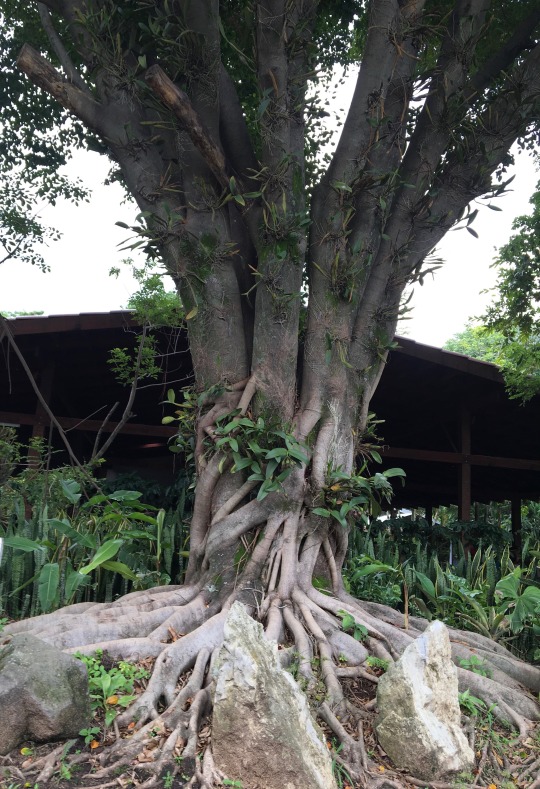
The purpose of meditation is to focus in a way that develops awareness or mindfulness; it is the practice of noticing and accepting the present moment. In Meditation for Beginners, Kornfield (2008) explains that mindfulness meditation is “an exercise in training your awareness, of being present,” and asserts that a good meditation practice is any practice that develops “awareness or mindfulness of our body and our senses, our mind and heart.”
While paying attention to the present moment and how we feel in it seems easy enough, in my experience, this is not often the case! My own experiences with meditation and those shared by others, have led me to understand that no matter one’s “level” of experience, it is quite common to experience certain challenges in practicing meditation. During meditation, for example, at times you may feel as if you are “fighting yourself” due to thoughts about and reactions to bodily sensations or feelings that you notice, or when you catch your mind wandering or becoming occupied in ways that you rather it would not at that particular moment. This is the mind noticing “what is,” while also creating a “story” of judgment around it, rather than just accepting it “as is.” Our minds can be so quick in creating or re-telling stories of judgment around what we notice, that we often don’t realize that the phenomena and the story are not the same thing. Meditation can help us slow down our thinking just enough to find a little “space” between what is and our thoughts about what is. In practicing meditation, it is possible to train your mind to find and use this space as a way of accepting the present moment, thereby becoming truly mindful.

My experiences have provided certain understanding about the challenges of “fighting yourself” during meditation. I’ve learned these challenges crop up with frustrating frequency the more one is focused on meditating “correctly.” (Isn’t that usually forefront in the mind of a beginner of any skill, the whole self-conscious wondering, Am I doing this right?) Experiencing such challenges can even be frustrating to the point of abandoning the practice all together. As a beginner in mediation, I allowed such frustrations to fluster me to the point of claiming failure and abandoning further attempts for years. However, in giving meditation another try, (and another and another,) I have found responding to these challenges with acceptance rather than judgment makes the practice well worth the efforts.
Any beginner to meditation experiencing challenges should know that they are in like (and large) company! If you are such a beginner, you may find a certain comfort in this, and I offer it not just as a comfort, but as encouragement for you to accept these challenges as a natural part of the practice. Mindfulness, after all, is more than just our awareness of the present moment; it is also our ability to calmly acknowledge and accept our feelings, thoughts, and bodily sensations within the present moment. Therefore, in finding yourself faced with such challenges during meditation, I encourage you to take a breath and soften yourself into the moment. Use the challenge as an opportunity to become gentle with yourself and patient with the process. If the goal of meditation is becoming mindful, then as soon as you accept whatever you notice showing up during your meditation, you are practicing mindfulness!
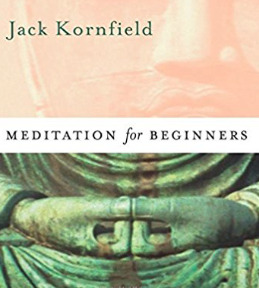
The meditations offered by Kornfield are designed to “help shine the light of mindfulness” on every aspect of daily experience and to “show you how to extend the healing power of lovingkindness to yourself and others.” Accepting what you notice during meditation is extending lovingkindness to yourself. My experiences with his meditations as well as other mindful practices, allow me to see that the more I offer lovingkindness to myself, the easier and more frequently I extend it towards others. And just as Kornfield asserts, I find the more I practice lovingkindness, the easier it is for me to accept what I notice during meditation as well as in many other aspects of my daily life. Namaste.
~Z Harmony
February 28, 2018
References:
Kornfield, J. (2008). Meditation for Beginners. Boulder, CO: Sounds True, Inc.
Mindfulness. (2015). En.oxforddictionaries.com. Retrieved from https://en.oxforddictionaries.com/definition/mindfulness
0 notes
Quote
I know now that I don’t want to love or be loved in half measures. I want it all, and to have it all, you have to risk it all.
Jenny Han, P.S. I Still Love You (via books-n-quotes)
932 notes
·
View notes
Text
What to do When You Feel Overwhelmed
1. Unplug from social media and, if possible, switch off your phone.
2. Try to drop all non-essential commitments.
3. Make sure you get out of the house. Deliberately change your environment each day.
4. Make a list of the things you CAN do, and begin by changing at least one of them.
5. Get a grip of the negative thought patterns. Try to focus on something positive.
6. Ask for help from someone who is safe, either a professional or someone you know cares.
2K notes
·
View notes
Quote
Always be committed to developing your mind. Learn something new every single day. Read things that no one else is reading. Never stop learning new knowledge, for we were given this amazing ability for a reason.
Nicole Addison @thepowerwithin (via thepowerwithin)
12K notes
·
View notes
Photo


“we’ve all got both light and dark inside us. what matters is the part we choose to act on.” - sirius black
29K notes
·
View notes
Text
“Let’s get loose
with compassion,
Let’s drown in the
delicious ambiance of
love.”
Hafiz
83 notes
·
View notes
Quote
Create whatever causes a revolution in your heart.
Big Magic by Elizabeth Gilbert
(via absintheandbooks)
13 notes
·
View notes
Text
Giving the Elbow to Moral Outrage
The following perspective has grown out of email exchanges with a friend as we communicated how we’ve been experiencing the current political landscape. What has it brought up in (and out of) us? How are we showing up to the issues and to our feelings about them? How are we showing up to others? How are we navigating the stormy seas of discord? Are we practicing self-care? Are we practicing compassion? In the “age of moral outrage,” how can we have meaningful exchanges with others on the “opposite side” of an issue?

Such written exchanges allow me to explore patterns in how we engage with others, especially on social media. Perhaps exchanges on social media are so often framed by such adversarial, “either/or” thinking (especially those of a “political” nature) because of the new frequency at which we gut-check the information bombarding us from everywhere, and measuring countless issues against our own moral compass, pointing towards our northern star, aligning our actions with our beliefs. “This is right, that is wrong. Therefore, I will do this, but I won’t do that. I admire this, but abhor that.” (And how many of these countless issues really count as meaningful and worthy of all the energy spent on them?)
Gut-checks on such issues can happen instantaneously, and by extension, so too can our judgment of others, especially of those who don’t see things as we do. How quickly, especially on social media, do we extend our judgment well beyond events and issues and onto other people, many of whom we know quite well? How swiftly and carelessly do we throw about labels, not just to describe or categorize things, but to define fellow humans, and end up judging each other? When we instantly judge the other, is it done with consideration of the values and experiences of the individual, or only by considering our own values and experiences, and our assumptions of the people who hold such different views? How often do we negate others with our judgments? With our speaking? With our actions? And not just negate their opinions on a matter, but negate their beliefs, their experiences, their very existence?
Have we allowed our anger and fear over the dehumanizing of certain groups by other groups, to blind us to our own growing intolerance? Are we allowing ourselves to become intolerant of not just certain ideas, or the dehumanizing ideas promoted by specific groups of people, but of people themselves? Aren’t we showing an intolerance towards individuals, friends as well as strangers, and thereby creating foes, each time we show up to a showdown of words on social media, raining bullets all around us, and wounding others, even as we denounce such intolerance?
What are the consequences of negating the experiences and feelings of others? Of excluding the opinions and voices of those who place a different value on things than we do? (Have we forgotten that holding a different value is not equivalent to seeing no value at all in something? So why must we react as such?) What happens to our society when we cannot tolerate even hearing out the thoughts of someone with a different perspective? What does it cost us to hear them out? What does it cost us when we don’t? How do we communicate through such a sharp “political divide,” without sharpening our own weapons and brandishing them with moral superiority as soon as we’re baited? (And doesn’t our growing intolerance just provide people who disagree with our views greater opportunities to slap the label of “hypocrite” on us, and completely negate us?

Is it even possible for us to experience civil discourse and truly discuss an issue through a real exchange of ideas anymore? I believe the answer to that question is a resounding yes. Yes, and it may not be easy, but it is possible. Yes, and it starts with taking personal responsibility. Yes, and I can begin with small steps. Yes, and it will take me responding to others in ways I’m not yet practiced. Yes, and I can show up to others in new ways to create this experience for myself and others. Yes, and it will take more effort, but I believe it is worth it!
To begin the shift towards creating a different experience, I’ve increasingly turned towards searching for the shades of grey in the issues that seem to be only “black or white.” Shifting away from declarations and pronouncements and towards curiosity and offerings, I’m taking small steps towards “the other” with less judgment and more compassion as I practice “the nudge” towards more common ground.
Elbowing with Empathy
The following is an example of how I show up on social media with small, shaky steps towards keeping judgment on the issues, not the people. A dear cousin of mine, who believes we should “free our minds” from what the media dictates (an opinion we share), posted an article on Facebook about media bias, (which pointed out to me some things about our own biases, including where and how they differ.) News stories posted by this cousin are most often from media sources with a conservative bias, ranging from slight to extreme bias. The article she shared in this example came from a site that is categorized as having “moderate to strong bias” by mediabiasfactcheck.com. Commenting in the manner I did below, I attempted to engage someone who holds a different view of what is considered “untrustworthy media” with a nudge rather than pounding my views on her like a sledgehammer. The screenshot below shows the article she shared and my original comment on it.

Could I have phrased it differently or even posed it as a question or two or five? Yes. And had I done so, maybe her response to my comment would have been different. But this is the phrasing I used. And the immediate response by my loved one was a typical initial reaction, aimed to elicit a particular response through the use of baited phrasing (and almost all of us have done it in some form or another…)
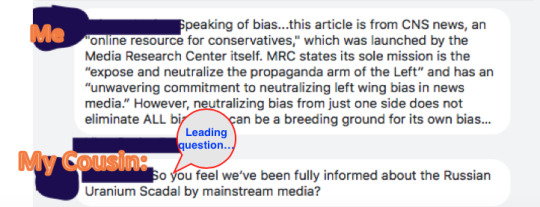
But is her question the most pressing one to ask here? A few things caught my eye that made me think not…
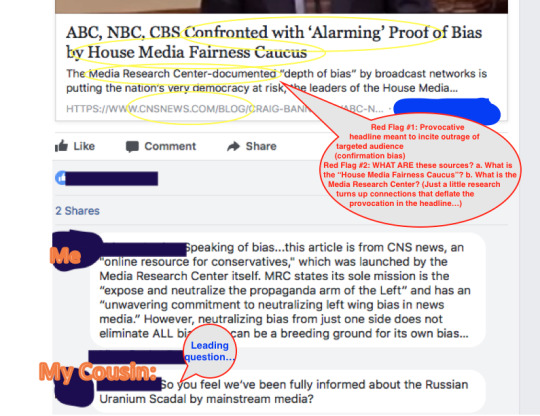
Now I’m no expert on Congress, but I’m tuned in enough that I’m familiar with commonly known committees and I didn’t recognize the name “House Media Fairness Caucus.” (Of course, that’s because a caucus is not a formal committee, even though it sounds like one. It is an informal organization of Congressional members to discuss issues of mutual concern.) So, I clearly needed to learn more about this caucus, whose leaders have just stated (according to this post) that “the depth of bias by broadcast networks is putting the nation’s democracy at risk,” as was documented by this Media Research Center. (And that phrase sounds, well, alarming, doesn’t it?) Of course, I’d learn more about this caucus before commenting about it on my cousin’s FB page, as well as learn about what the Media Research Center is (never heard of that one before either.) But first, I’d need to find out more about “CNS News” site to decide for myself how credible all this information really was.
Side note: After some basic research, here’s what I learned about the House Media Fairness Caucus: it was formed by “a dozen Republican members of Congress” in 2009 led by Lamar Smith (TX), and currently co-chaired by Smith and Alex Mooney (VA); and its purpose, as stated on Congressman Smith’s official house.gov page, is to “encourage the media to adhere to the highest standards of their profession, and to provide the American people with the facts, not tell them what to think.” Interesting though, that the source of this article posted by my cousin comes directly from the blog page of the Media Research Center. Yes indeed, that is the very organization that generated this “alarming proof” in the first place! How can that be?! Because “CNS News” is not a news source that adheres to the standards of journalism and its code of ethics. No, “CNS News” is really…(and yes, the following quote comes directly from their site…) “NewsBusters.org: a project of the Media Research Center, America’s leading media watchdog in documenting, exposing and neutralizing liberal news bias.” (My, what a gift this harmless, little writing project is, coming directly to me on Facebook from someone I love and trust, all wrapped up in a pretty bow of provocatively misleading phrases! I sure am glad this project adheres to such high standards, [whose standards?!] presenting us with facts rather than telling us what to think! Wait a minute... on second thought [can we have those?] this piece does seem to be trying to tell me what to think…Oh well, it’s not a liberal bias after all, so it’s all good!) I wonder no more about why this caucus was a new one on me as it seems to be the Congressional equivalent of a PTA meeting, only with fewer people…Ooops! I’m afraid this side note has shown more than just my sarcastic wit, but also my liberal bias! Oh dear…let me see if I can ever find my way back to my point…did I ever even have one?! (I’m such a flaky little snowflake…)
WWLD?
Of course, I have several points, and here’s my next one: just like the character Leo McGarry from The West Wing, I did not accept the premise of her question. Instead of following my cousin’s question to a place upon which she was ready to go (locked and loaded,) my next response was based in evidence that speaks to her belief in not allowing media to dictate one’s opinions. Why look at that, common ground, in a lovely shade of grey! (Until I’m struck down by the flick of an evil, magic wand for including the phrase “based in evidence.” Even so, I’d rather focus on this beautiful shade of grey, than shades of idiocracy.) Since this belief is also a part of the image reflected on her FB page, it left my cousin without a strong “push-back” towards me that squares with that image. Besides, she loves and respects me, so that is where she left it… But alas, a new voice chimed in!
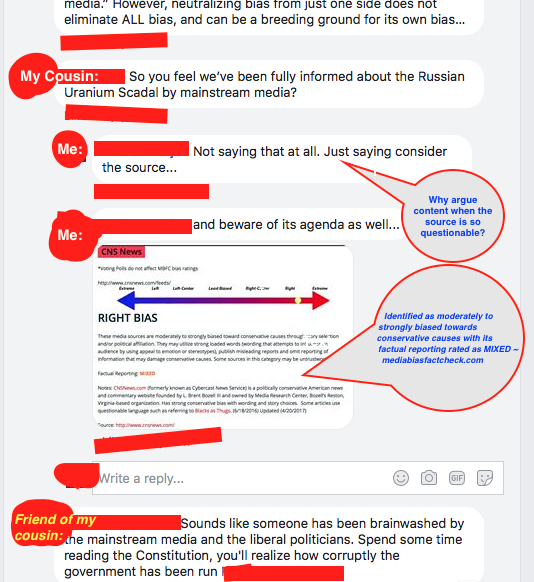
There it is, right on cue, a friend who likely gathers his information from the same sources as my cousin, chimes in to show the opposition what’s what. How fun, new bait!
BTW: I found his comment quite comical in its irony, and literally laughed out loud. (You’re about to get the joke too, I promise.) Apparently, I didn’t provide him with a sufficient reaction because when I laughed instead of biting, he didn’t laugh along, he just dangled juicier, more personal bait my way...

Yes, yes, I got a little “cheeky” there, but I wasn’t angry and hey, teachers like to have fun too! We get offered this kind of bait (in multiples) on the daily...
And that’s where this exchange ended. I didn’t hear back again on this matter from my cousin, nor her friend. There were many possibilities as to how this exchange could have gone. (Including no exchange at all, just judgmental silence on my part.) Yes, I could have done it better. And I could’ve done a lot worse too, including some damage to a treasured relationship with my cousin. Did I “win over opponents” to my “side”? Ha! As if that’s the point here! However, I believe I did achieve my goal of engaging someone who holds a different view from mine and did so in a different way – using a bit of a nudge without any moral outrage. I know, I didn’t achieve a true exchange of ideas, either. Yes, that is true. And communication did not devolve into a “tit for tat” match either, and this may all be part of laying the groundwork to get there. (There is no “one and done” in these exchanges. Just like good parenting and teaching of kids, it’s all about consistency.) No, I didn’t win over any friends either, even after sending him a “winky-face” while refraining from name-calling! (C’mon, that deserves a medal! I am a Snowflake after all, so I should at least get my participation trophy, right?)
Seriously though, I also just may have influenced people too. Don’t know for sure, but since they both dropped the baiting tactics, let’s consider that a small victory on the road towards more compassionate communication, and keep traveling a more peaceful path. Because, well let’s get real here: neither “side” of any of these adversarial exchanges on social media are productive in the powers of persuasion. No matter how logically sound, or cleverly phrased an argument is, it’s still argument. How can we ever get to true civil discourse if all we’re doing is lobbing grenades at one another? We’ll even pick up grenades thrown at us and just lob them right back. Now is not the time of showing how right or how clever we are. It only looks ridiculous to the “other side” anyway. What is needed now is to use our words to build bridges across the divide and build relationships. With every exchange, express a little empathy. Sometimes all that takes is to lay down an assumption and get a little curious. So ask questions. What makes you say that? Why do you feel that way? What experience do you have with this? What information do you have that I don’t....

Bottom line: I’m not saying, “Why don’t we all just play nice?” because who cares about nice when everything else is falling apart?! Maybe we’ve “played nice” for too long already, with lots of judgmental silence just hanging in the air like odorless poison. Maybe now it’s time to get a little dirty, not with trickery, fraud, or even our cleverness, but in getting a little more comfortable with the uncomfortable. Let’s not wait another moment for “the other side” to change their minds. Let’s not wait another moment to reach out across the divide looking for allies instead of adversaries. Let’s not wait another moment to add more empathy, however awkwardly, into our “fierce conversations.” Let’s speak truth to power, and to each other, and temper it all with compassion. Perhaps if enough of us make such a shift even in small ways, we’ll all reap some benefits. Maybe just a little shake up in how we engage one another in each interaction, is the beginning of ensuring we’ll all come out of this time of divisiveness as a more united people. As more tolerant and understanding people. Maybe we are the ones we’ve been waiting for to ameliorate our collective wounds. Who knows? Anything is possible in world framed by Yes, and…
Love & Peace,
Z Harmony January 4, 2018
0 notes
